Australian Indigenous Elders Healthcare: Policy Impact Analysis
VerifiedAdded on 2023/06/03
|12
|3044
|359
Essay
AI Summary
This essay examines the healthcare status of Australian Indigenous Elders, focusing on the impact of the 1961 Assimilation Policy. It explores the pre-invasion health, current health disparities, and the effects of the policy on cardiovascular and chronic kidney diseases. The assignment also addresses the impact on end-of-life care and cultural safety, including the importance of culturally sensitive healthcare practices. The discussion covers the international treaty on indigenous people, the role of nurses, and the need for universal healthcare. It highlights the historical context, the challenges faced by Indigenous Elders, and the importance of addressing health inequities. The essay concludes with a call for culturally safe medical attention to reduce mortality rates and improve the quality of life for Australian Indigenous Elders.

Healthcare for Australian Indigenous Elders 1
HEALTHCARE FOR AUSTRALIAN INDIGENOUS ELDERS
By [Name]
Course
Professor’s Name
Institution
Location of Institution
Date
HEALTHCARE FOR AUSTRALIAN INDIGENOUS ELDERS
By [Name]
Course
Professor’s Name
Institution
Location of Institution
Date
Paraphrase This Document
Need a fresh take? Get an instant paraphrase of this document with our AI Paraphraser

Healthcare for Australian Indigenous Elders 2
Pre-Invasion Health Status of Indigenous Australian Elders
The health status of the elders was better during the pre-invasion stage that at the post-
invasion error. During the pre-contact period, the healthcare system relied on three aspects of
social inter-relationships to provide quality medical attention. The relationship between the
indigenous elders and their land, creator beings, and other ages offered culturally-sensitive care
(Braun et al., 2013). The Aboriginals researched diseases and provided answers to family,
community, and personal health concerns. However, the introduction of the healthcare policies
interfered with the Elders' quest for quality medical attention. Therefore, the Aboriginal's health
deteriorated post-invasion.
Current Health Status of Indigenous Australian Elders
The Elders believed and witnessed a decline in their status of health after the invasion by
the western settlers. The settling of the Europeans increased the health problems among the
Aboriginal population. Therefore, the mortality and the morbidity rates have been rising since
the beginning of the invasion. The elderly indigenous people believed that the western people
brought diseases to their land (Marrone, 2007). They also have a notion that the invasion has
caused a decline in their socio-economic prowess. Therefore, the growing levels of poverty have
hindered the elderly individuals from accessing quality healthcare.
Assimilation Policy of 1961
The policy intended to incorporate the indigenous people into the white majority
Australian tribes. The government proposed to achieve its mission by taking fair-skinned
Indigenous young ones from their parents (Findandconnect.gov.au, 1961). The authorities took
the children to specialized institutions for training on the ways of the white tribes. The primary
objective of the policy was to destroy the indigenous societies. The elders that underwent
Pre-Invasion Health Status of Indigenous Australian Elders
The health status of the elders was better during the pre-invasion stage that at the post-
invasion error. During the pre-contact period, the healthcare system relied on three aspects of
social inter-relationships to provide quality medical attention. The relationship between the
indigenous elders and their land, creator beings, and other ages offered culturally-sensitive care
(Braun et al., 2013). The Aboriginals researched diseases and provided answers to family,
community, and personal health concerns. However, the introduction of the healthcare policies
interfered with the Elders' quest for quality medical attention. Therefore, the Aboriginal's health
deteriorated post-invasion.
Current Health Status of Indigenous Australian Elders
The Elders believed and witnessed a decline in their status of health after the invasion by
the western settlers. The settling of the Europeans increased the health problems among the
Aboriginal population. Therefore, the mortality and the morbidity rates have been rising since
the beginning of the invasion. The elderly indigenous people believed that the western people
brought diseases to their land (Marrone, 2007). They also have a notion that the invasion has
caused a decline in their socio-economic prowess. Therefore, the growing levels of poverty have
hindered the elderly individuals from accessing quality healthcare.
Assimilation Policy of 1961
The policy intended to incorporate the indigenous people into the white majority
Australian tribes. The government proposed to achieve its mission by taking fair-skinned
Indigenous young ones from their parents (Findandconnect.gov.au, 1961). The authorities took
the children to specialized institutions for training on the ways of the white tribes. The primary
objective of the policy was to destroy the indigenous societies. The elders that underwent
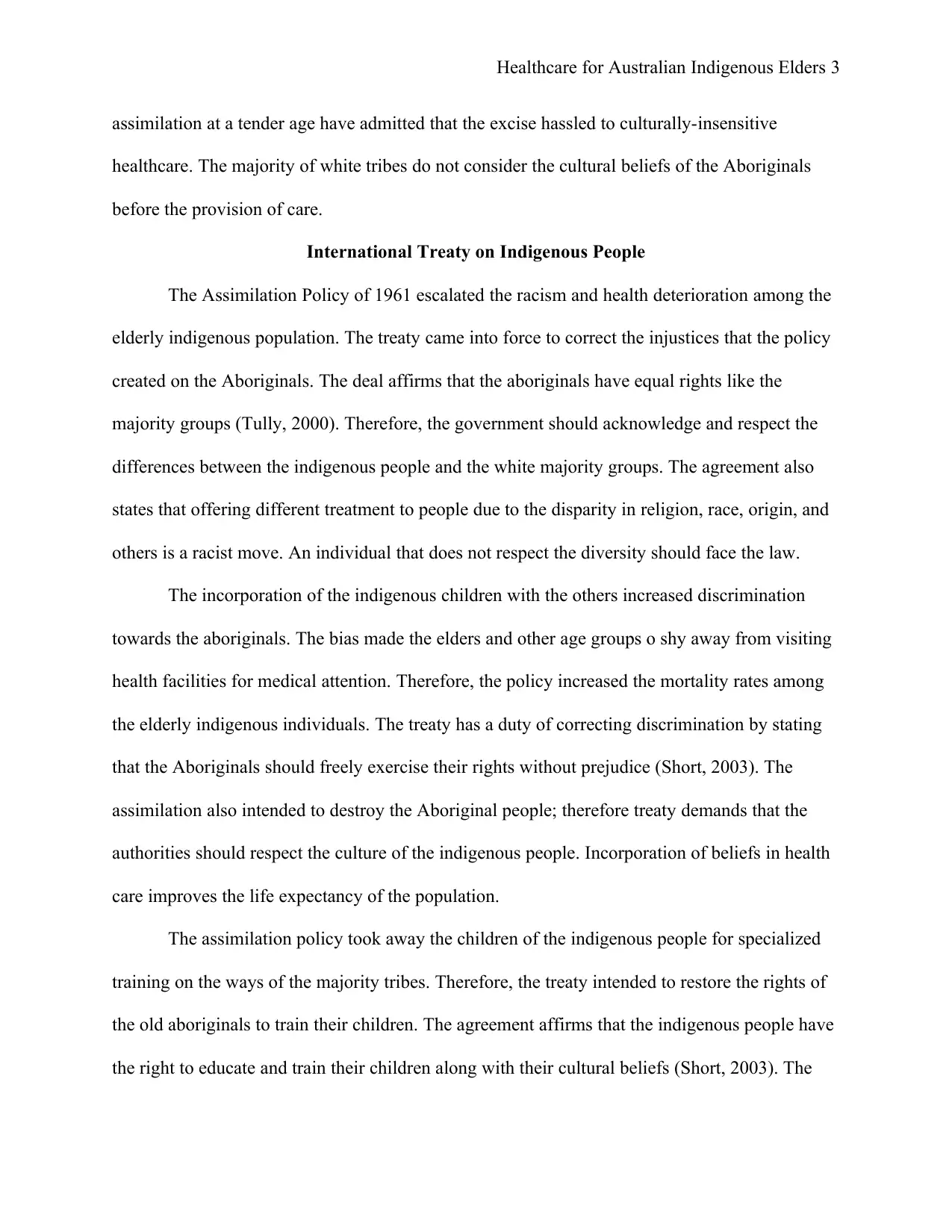
Healthcare for Australian Indigenous Elders 3
assimilation at a tender age have admitted that the excise hassled to culturally-insensitive
healthcare. The majority of white tribes do not consider the cultural beliefs of the Aboriginals
before the provision of care.
International Treaty on Indigenous People
The Assimilation Policy of 1961 escalated the racism and health deterioration among the
elderly indigenous population. The treaty came into force to correct the injustices that the policy
created on the Aboriginals. The deal affirms that the aboriginals have equal rights like the
majority groups (Tully, 2000). Therefore, the government should acknowledge and respect the
differences between the indigenous people and the white majority groups. The agreement also
states that offering different treatment to people due to the disparity in religion, race, origin, and
others is a racist move. An individual that does not respect the diversity should face the law.
The incorporation of the indigenous children with the others increased discrimination
towards the aboriginals. The bias made the elders and other age groups o shy away from visiting
health facilities for medical attention. Therefore, the policy increased the mortality rates among
the elderly indigenous individuals. The treaty has a duty of correcting discrimination by stating
that the Aboriginals should freely exercise their rights without prejudice (Short, 2003). The
assimilation also intended to destroy the Aboriginal people; therefore treaty demands that the
authorities should respect the culture of the indigenous people. Incorporation of beliefs in health
care improves the life expectancy of the population.
The assimilation policy took away the children of the indigenous people for specialized
training on the ways of the majority tribes. Therefore, the treaty intended to restore the rights of
the old aboriginals to train their children. The agreement affirms that the indigenous people have
the right to educate and train their children along with their cultural beliefs (Short, 2003). The
assimilation at a tender age have admitted that the excise hassled to culturally-insensitive
healthcare. The majority of white tribes do not consider the cultural beliefs of the Aboriginals
before the provision of care.
International Treaty on Indigenous People
The Assimilation Policy of 1961 escalated the racism and health deterioration among the
elderly indigenous population. The treaty came into force to correct the injustices that the policy
created on the Aboriginals. The deal affirms that the aboriginals have equal rights like the
majority groups (Tully, 2000). Therefore, the government should acknowledge and respect the
differences between the indigenous people and the white majority groups. The agreement also
states that offering different treatment to people due to the disparity in religion, race, origin, and
others is a racist move. An individual that does not respect the diversity should face the law.
The incorporation of the indigenous children with the others increased discrimination
towards the aboriginals. The bias made the elders and other age groups o shy away from visiting
health facilities for medical attention. Therefore, the policy increased the mortality rates among
the elderly indigenous individuals. The treaty has a duty of correcting discrimination by stating
that the Aboriginals should freely exercise their rights without prejudice (Short, 2003). The
assimilation also intended to destroy the Aboriginal people; therefore treaty demands that the
authorities should respect the culture of the indigenous people. Incorporation of beliefs in health
care improves the life expectancy of the population.
The assimilation policy took away the children of the indigenous people for specialized
training on the ways of the majority tribes. Therefore, the treaty intended to restore the rights of
the old aboriginals to train their children. The agreement affirms that the indigenous people have
the right to educate and train their children along with their cultural beliefs (Short, 2003). The
⊘ This is a preview!⊘
Do you want full access?
Subscribe today to unlock all pages.

Trusted by 1+ million students worldwide
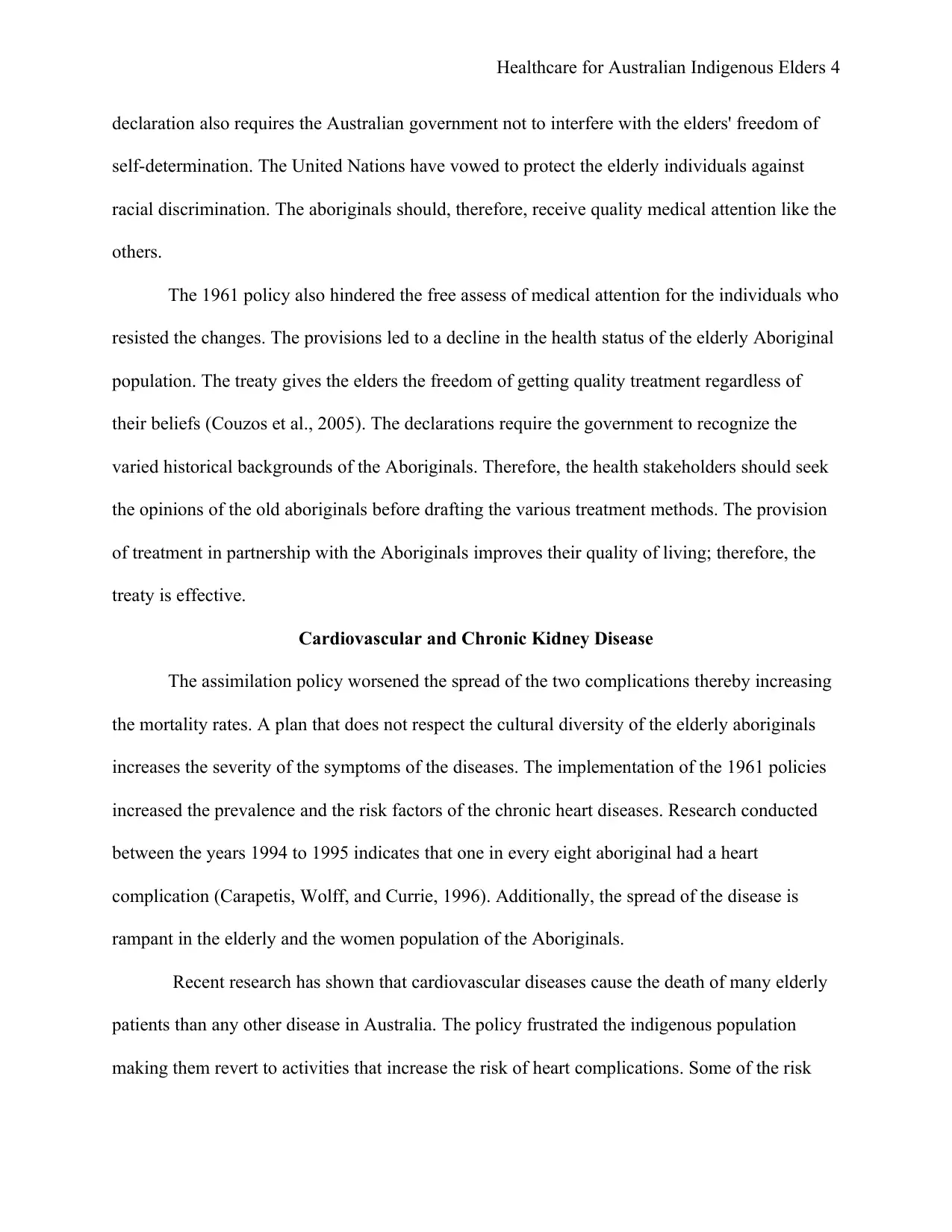
Healthcare for Australian Indigenous Elders 4
declaration also requires the Australian government not to interfere with the elders' freedom of
self-determination. The United Nations have vowed to protect the elderly individuals against
racial discrimination. The aboriginals should, therefore, receive quality medical attention like the
others.
The 1961 policy also hindered the free assess of medical attention for the individuals who
resisted the changes. The provisions led to a decline in the health status of the elderly Aboriginal
population. The treaty gives the elders the freedom of getting quality treatment regardless of
their beliefs (Couzos et al., 2005). The declarations require the government to recognize the
varied historical backgrounds of the Aboriginals. Therefore, the health stakeholders should seek
the opinions of the old aboriginals before drafting the various treatment methods. The provision
of treatment in partnership with the Aboriginals improves their quality of living; therefore, the
treaty is effective.
Cardiovascular and Chronic Kidney Disease
The assimilation policy worsened the spread of the two complications thereby increasing
the mortality rates. A plan that does not respect the cultural diversity of the elderly aboriginals
increases the severity of the symptoms of the diseases. The implementation of the 1961 policies
increased the prevalence and the risk factors of the chronic heart diseases. Research conducted
between the years 1994 to 1995 indicates that one in every eight aboriginal had a heart
complication (Carapetis, Wolff, and Currie, 1996). Additionally, the spread of the disease is
rampant in the elderly and the women population of the Aboriginals.
Recent research has shown that cardiovascular diseases cause the death of many elderly
patients than any other disease in Australia. The policy frustrated the indigenous population
making them revert to activities that increase the risk of heart complications. Some of the risk
declaration also requires the Australian government not to interfere with the elders' freedom of
self-determination. The United Nations have vowed to protect the elderly individuals against
racial discrimination. The aboriginals should, therefore, receive quality medical attention like the
others.
The 1961 policy also hindered the free assess of medical attention for the individuals who
resisted the changes. The provisions led to a decline in the health status of the elderly Aboriginal
population. The treaty gives the elders the freedom of getting quality treatment regardless of
their beliefs (Couzos et al., 2005). The declarations require the government to recognize the
varied historical backgrounds of the Aboriginals. Therefore, the health stakeholders should seek
the opinions of the old aboriginals before drafting the various treatment methods. The provision
of treatment in partnership with the Aboriginals improves their quality of living; therefore, the
treaty is effective.
Cardiovascular and Chronic Kidney Disease
The assimilation policy worsened the spread of the two complications thereby increasing
the mortality rates. A plan that does not respect the cultural diversity of the elderly aboriginals
increases the severity of the symptoms of the diseases. The implementation of the 1961 policies
increased the prevalence and the risk factors of the chronic heart diseases. Research conducted
between the years 1994 to 1995 indicates that one in every eight aboriginal had a heart
complication (Carapetis, Wolff, and Currie, 1996). Additionally, the spread of the disease is
rampant in the elderly and the women population of the Aboriginals.
Recent research has shown that cardiovascular diseases cause the death of many elderly
patients than any other disease in Australia. The policy frustrated the indigenous population
making them revert to activities that increase the risk of heart complications. Some of the risk
Paraphrase This Document
Need a fresh take? Get an instant paraphrase of this document with our AI Paraphraser

Healthcare for Australian Indigenous Elders 5
factors of the complexity include physical inactivity due to old age and cigarette smoking
(Carapetis, Wolff, and Currie, 1996). Other factors include diabetes, obesity, hypertension, and
elevated consumption of alcohol. The discrimination due to the assimilation policy has made the
disease to be more rampant in the indigenous than the white majority groups. Furthermore, the
elderly indigenous population records more risk factors than the non-indigenous groups.
The elderly indigenous population has also witnessed an elevation in the spread of
chronic kidney disease due to the impact of the assimilation policy. The culturally-insensitive
regulations have reduced the quality of an elder's life. Additionally, the health outcomes from
treatment are poor due to the lack of person-centered care. The 1961 legislations concentrated
health facilities in the urban centers away from the aboriginals. Therefore, the elders having the
kidney complications cannot travel to the metropolitan regions for treatment due to high
transport costs (Zhang, and Rothenbacher, 2008). Recent research has indicated that caregivers
report a majority of kidney diseases in the indigenous patients than the non-indigenous
individuals.
Apart from the epidemiology, the hospitalization rates due to the complication are higher
in the elderly aboriginals than the rest of Australians. Additionally, the elderly indigenous
population recorded higher death rates than the other age groups (Hoy et al., 1998). The elevated
mortality rates are making the government spend a lot of funds in treating the patients with the
disease. Just like cardiovascular complications, the remote location of the old aboriginals hinders
their access to quality medical attention. The assimilation policy is responsible for the increased
death rates due to cardiovascular and chronic kidney diseases in Australia.
factors of the complexity include physical inactivity due to old age and cigarette smoking
(Carapetis, Wolff, and Currie, 1996). Other factors include diabetes, obesity, hypertension, and
elevated consumption of alcohol. The discrimination due to the assimilation policy has made the
disease to be more rampant in the indigenous than the white majority groups. Furthermore, the
elderly indigenous population records more risk factors than the non-indigenous groups.
The elderly indigenous population has also witnessed an elevation in the spread of
chronic kidney disease due to the impact of the assimilation policy. The culturally-insensitive
regulations have reduced the quality of an elder's life. Additionally, the health outcomes from
treatment are poor due to the lack of person-centered care. The 1961 legislations concentrated
health facilities in the urban centers away from the aboriginals. Therefore, the elders having the
kidney complications cannot travel to the metropolitan regions for treatment due to high
transport costs (Zhang, and Rothenbacher, 2008). Recent research has indicated that caregivers
report a majority of kidney diseases in the indigenous patients than the non-indigenous
individuals.
Apart from the epidemiology, the hospitalization rates due to the complication are higher
in the elderly aboriginals than the rest of Australians. Additionally, the elderly indigenous
population recorded higher death rates than the other age groups (Hoy et al., 1998). The elevated
mortality rates are making the government spend a lot of funds in treating the patients with the
disease. Just like cardiovascular complications, the remote location of the old aboriginals hinders
their access to quality medical attention. The assimilation policy is responsible for the increased
death rates due to cardiovascular and chronic kidney diseases in Australia.
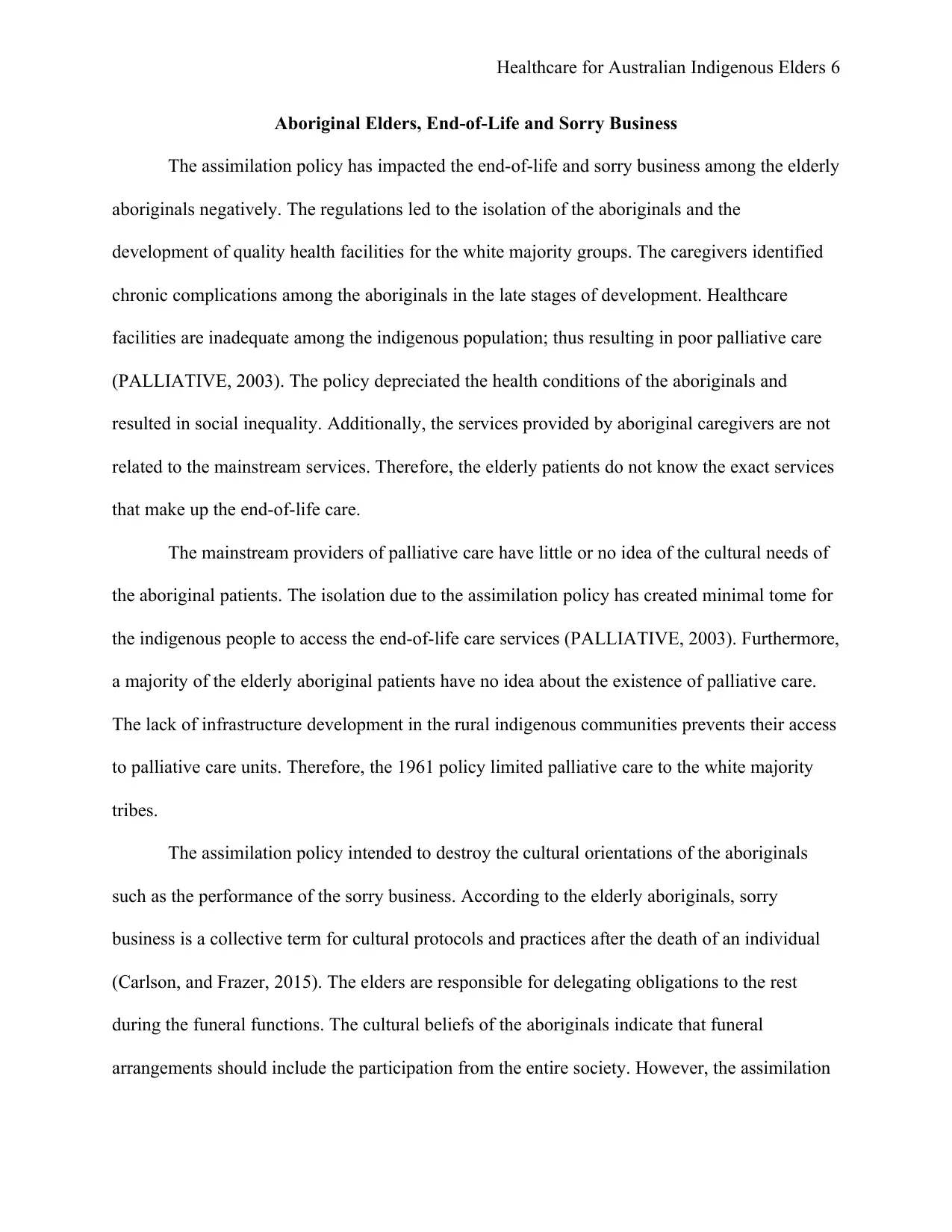
Healthcare for Australian Indigenous Elders 6
Aboriginal Elders, End-of-Life and Sorry Business
The assimilation policy has impacted the end-of-life and sorry business among the elderly
aboriginals negatively. The regulations led to the isolation of the aboriginals and the
development of quality health facilities for the white majority groups. The caregivers identified
chronic complications among the aboriginals in the late stages of development. Healthcare
facilities are inadequate among the indigenous population; thus resulting in poor palliative care
(PALLIATIVE, 2003). The policy depreciated the health conditions of the aboriginals and
resulted in social inequality. Additionally, the services provided by aboriginal caregivers are not
related to the mainstream services. Therefore, the elderly patients do not know the exact services
that make up the end-of-life care.
The mainstream providers of palliative care have little or no idea of the cultural needs of
the aboriginal patients. The isolation due to the assimilation policy has created minimal tome for
the indigenous people to access the end-of-life care services (PALLIATIVE, 2003). Furthermore,
a majority of the elderly aboriginal patients have no idea about the existence of palliative care.
The lack of infrastructure development in the rural indigenous communities prevents their access
to palliative care units. Therefore, the 1961 policy limited palliative care to the white majority
tribes.
The assimilation policy intended to destroy the cultural orientations of the aboriginals
such as the performance of the sorry business. According to the elderly aboriginals, sorry
business is a collective term for cultural protocols and practices after the death of an individual
(Carlson, and Frazer, 2015). The elders are responsible for delegating obligations to the rest
during the funeral functions. The cultural beliefs of the aboriginals indicate that funeral
arrangements should include the participation from the entire society. However, the assimilation
Aboriginal Elders, End-of-Life and Sorry Business
The assimilation policy has impacted the end-of-life and sorry business among the elderly
aboriginals negatively. The regulations led to the isolation of the aboriginals and the
development of quality health facilities for the white majority groups. The caregivers identified
chronic complications among the aboriginals in the late stages of development. Healthcare
facilities are inadequate among the indigenous population; thus resulting in poor palliative care
(PALLIATIVE, 2003). The policy depreciated the health conditions of the aboriginals and
resulted in social inequality. Additionally, the services provided by aboriginal caregivers are not
related to the mainstream services. Therefore, the elderly patients do not know the exact services
that make up the end-of-life care.
The mainstream providers of palliative care have little or no idea of the cultural needs of
the aboriginal patients. The isolation due to the assimilation policy has created minimal tome for
the indigenous people to access the end-of-life care services (PALLIATIVE, 2003). Furthermore,
a majority of the elderly aboriginal patients have no idea about the existence of palliative care.
The lack of infrastructure development in the rural indigenous communities prevents their access
to palliative care units. Therefore, the 1961 policy limited palliative care to the white majority
tribes.
The assimilation policy intended to destroy the cultural orientations of the aboriginals
such as the performance of the sorry business. According to the elderly aboriginals, sorry
business is a collective term for cultural protocols and practices after the death of an individual
(Carlson, and Frazer, 2015). The elders are responsible for delegating obligations to the rest
during the funeral functions. The cultural beliefs of the aboriginals indicate that funeral
arrangements should include the participation from the entire society. However, the assimilation
⊘ This is a preview!⊘
Do you want full access?
Subscribe today to unlock all pages.

Trusted by 1+ million students worldwide
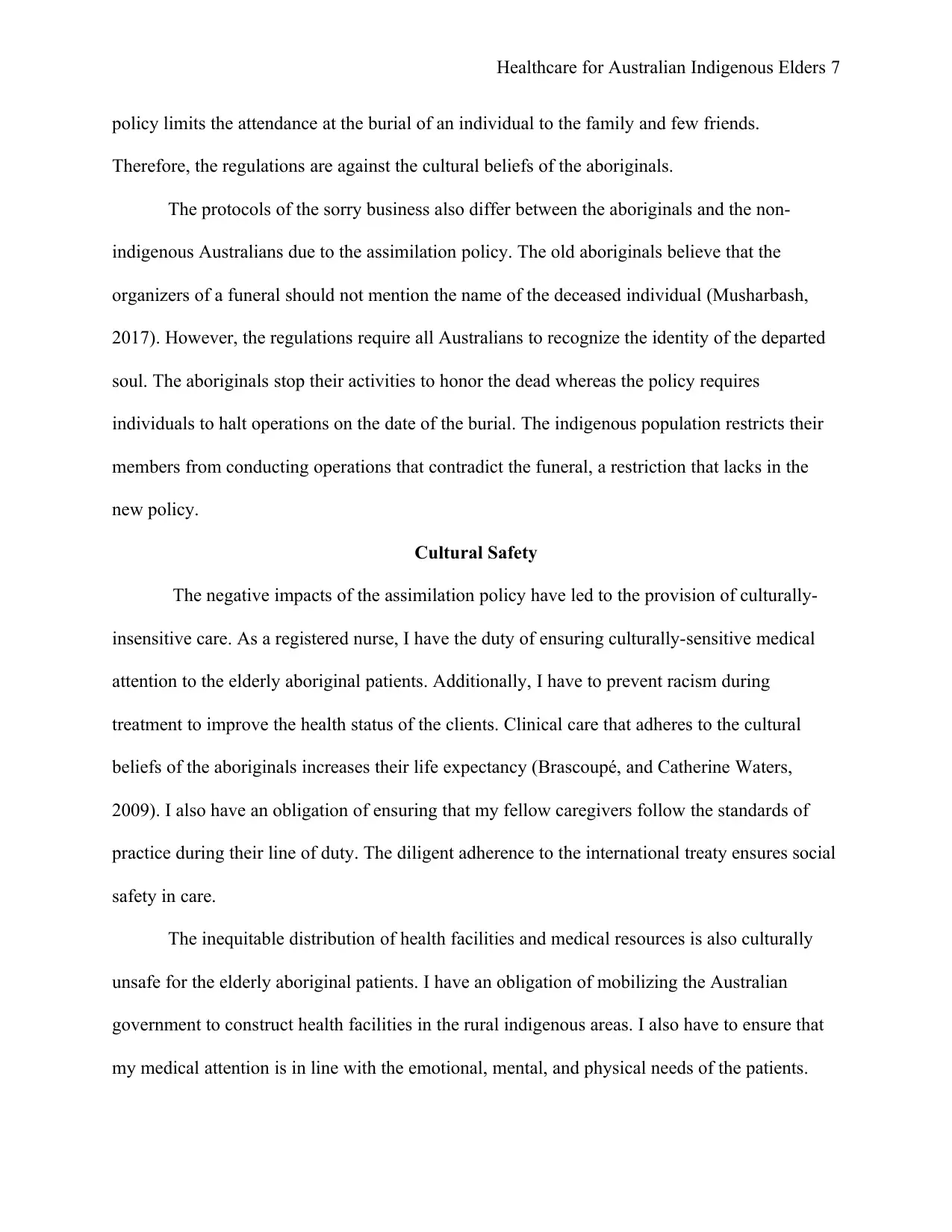
Healthcare for Australian Indigenous Elders 7
policy limits the attendance at the burial of an individual to the family and few friends.
Therefore, the regulations are against the cultural beliefs of the aboriginals.
The protocols of the sorry business also differ between the aboriginals and the non-
indigenous Australians due to the assimilation policy. The old aboriginals believe that the
organizers of a funeral should not mention the name of the deceased individual (Musharbash,
2017). However, the regulations require all Australians to recognize the identity of the departed
soul. The aboriginals stop their activities to honor the dead whereas the policy requires
individuals to halt operations on the date of the burial. The indigenous population restricts their
members from conducting operations that contradict the funeral, a restriction that lacks in the
new policy.
Cultural Safety
The negative impacts of the assimilation policy have led to the provision of culturally-
insensitive care. As a registered nurse, I have the duty of ensuring culturally-sensitive medical
attention to the elderly aboriginal patients. Additionally, I have to prevent racism during
treatment to improve the health status of the clients. Clinical care that adheres to the cultural
beliefs of the aboriginals increases their life expectancy (Brascoupé, and Catherine Waters,
2009). I also have an obligation of ensuring that my fellow caregivers follow the standards of
practice during their line of duty. The diligent adherence to the international treaty ensures social
safety in care.
The inequitable distribution of health facilities and medical resources is also culturally
unsafe for the elderly aboriginal patients. I have an obligation of mobilizing the Australian
government to construct health facilities in the rural indigenous areas. I also have to ensure that
my medical attention is in line with the emotional, mental, and physical needs of the patients.
policy limits the attendance at the burial of an individual to the family and few friends.
Therefore, the regulations are against the cultural beliefs of the aboriginals.
The protocols of the sorry business also differ between the aboriginals and the non-
indigenous Australians due to the assimilation policy. The old aboriginals believe that the
organizers of a funeral should not mention the name of the deceased individual (Musharbash,
2017). However, the regulations require all Australians to recognize the identity of the departed
soul. The aboriginals stop their activities to honor the dead whereas the policy requires
individuals to halt operations on the date of the burial. The indigenous population restricts their
members from conducting operations that contradict the funeral, a restriction that lacks in the
new policy.
Cultural Safety
The negative impacts of the assimilation policy have led to the provision of culturally-
insensitive care. As a registered nurse, I have the duty of ensuring culturally-sensitive medical
attention to the elderly aboriginal patients. Additionally, I have to prevent racism during
treatment to improve the health status of the clients. Clinical care that adheres to the cultural
beliefs of the aboriginals increases their life expectancy (Brascoupé, and Catherine Waters,
2009). I also have an obligation of ensuring that my fellow caregivers follow the standards of
practice during their line of duty. The diligent adherence to the international treaty ensures social
safety in care.
The inequitable distribution of health facilities and medical resources is also culturally
unsafe for the elderly aboriginal patients. I have an obligation of mobilizing the Australian
government to construct health facilities in the rural indigenous areas. I also have to ensure that
my medical attention is in line with the emotional, mental, and physical needs of the patients.
Paraphrase This Document
Need a fresh take? Get an instant paraphrase of this document with our AI Paraphraser

Healthcare for Australian Indigenous Elders 8
Additionally, I should ask the hospital administrator to facilitate the recruitment of Aboriginal
doctors who understand the culture of the clients. Furthermore, I intend to train the indigenous
patients to learn the English language; since the language barrier impedes conclusive medical
attention.
The Australian government should incorporate the cultural beliefs of the patients before
forming the treatment methods. As an RN, I have the responsibility of explaining the treatment
methods to the old indigenous patents and allowing them to make their choices. The indigenous
community has financial constraints which should not prevent them from receiving quality
medical attention (Mbuzi, Fulbrook, and Jessup, 2017). I have the duty of mobilizing the health
stakeholders to introduce universal healthcare to every Australian citizen despite the difference
in race and origin. Additionally, the aboriginals should have equal chances of receiving
specialized treatment like angiography like the other Australian tribes.
The primary cause of mortality among the aboriginals is the chronic heart disease. Cancer
follows cardiovascular diseases in the killer list for the indigenous population. Recent research
has also shown that death rates due to cardiovascular diseases are high in the aboriginals than the
majority tribes (Sahle et al., 2016). The grim statistics are due to lack of culturally-safe medical
attention for the aboriginals. I have the duty of ensuring cultural safety during medical care to
reduce the mortality rates. Furthermore, I have to ask the aboriginals about their opinion on the
methods of reducing the death rates due to the chronic complications like cancer.
The main barriers to culturally-sensitive medical attention are the communication
difficulties and discrimination. I have the duty of persuading the hospital administrator to hire a
language translator for patients who do not understand English. The Australian government
should educate the aboriginals on the language of the majority tribes to break the barrier of
Additionally, I should ask the hospital administrator to facilitate the recruitment of Aboriginal
doctors who understand the culture of the clients. Furthermore, I intend to train the indigenous
patients to learn the English language; since the language barrier impedes conclusive medical
attention.
The Australian government should incorporate the cultural beliefs of the patients before
forming the treatment methods. As an RN, I have the responsibility of explaining the treatment
methods to the old indigenous patents and allowing them to make their choices. The indigenous
community has financial constraints which should not prevent them from receiving quality
medical attention (Mbuzi, Fulbrook, and Jessup, 2017). I have the duty of mobilizing the health
stakeholders to introduce universal healthcare to every Australian citizen despite the difference
in race and origin. Additionally, the aboriginals should have equal chances of receiving
specialized treatment like angiography like the other Australian tribes.
The primary cause of mortality among the aboriginals is the chronic heart disease. Cancer
follows cardiovascular diseases in the killer list for the indigenous population. Recent research
has also shown that death rates due to cardiovascular diseases are high in the aboriginals than the
majority tribes (Sahle et al., 2016). The grim statistics are due to lack of culturally-safe medical
attention for the aboriginals. I have the duty of ensuring cultural safety during medical care to
reduce the mortality rates. Furthermore, I have to ask the aboriginals about their opinion on the
methods of reducing the death rates due to the chronic complications like cancer.
The main barriers to culturally-sensitive medical attention are the communication
difficulties and discrimination. I have the duty of persuading the hospital administrator to hire a
language translator for patients who do not understand English. The Australian government
should educate the aboriginals on the language of the majority tribes to break the barrier of
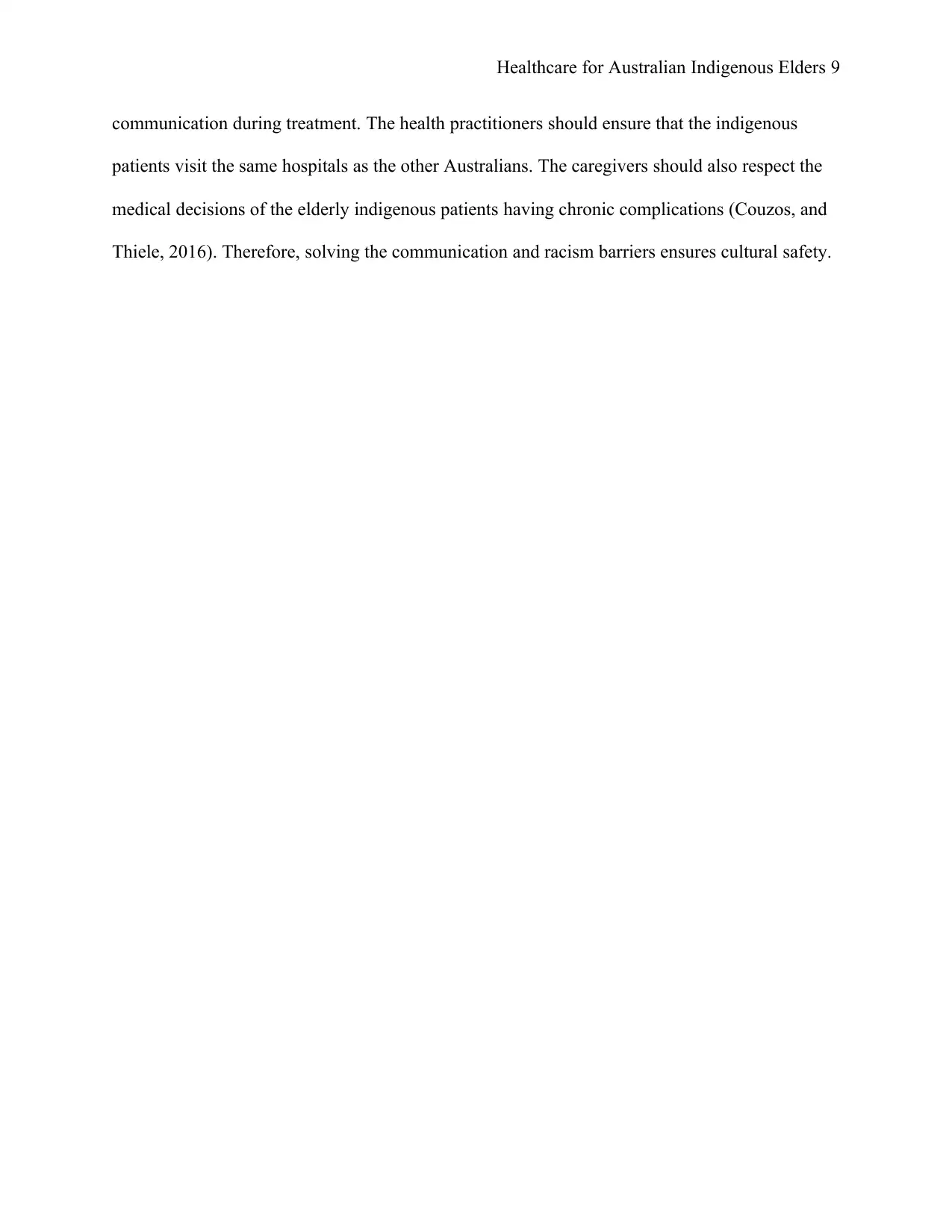
Healthcare for Australian Indigenous Elders 9
communication during treatment. The health practitioners should ensure that the indigenous
patients visit the same hospitals as the other Australians. The caregivers should also respect the
medical decisions of the elderly indigenous patients having chronic complications (Couzos, and
Thiele, 2016). Therefore, solving the communication and racism barriers ensures cultural safety.
communication during treatment. The health practitioners should ensure that the indigenous
patients visit the same hospitals as the other Australians. The caregivers should also respect the
medical decisions of the elderly indigenous patients having chronic complications (Couzos, and
Thiele, 2016). Therefore, solving the communication and racism barriers ensures cultural safety.
⊘ This is a preview!⊘
Do you want full access?
Subscribe today to unlock all pages.

Trusted by 1+ million students worldwide
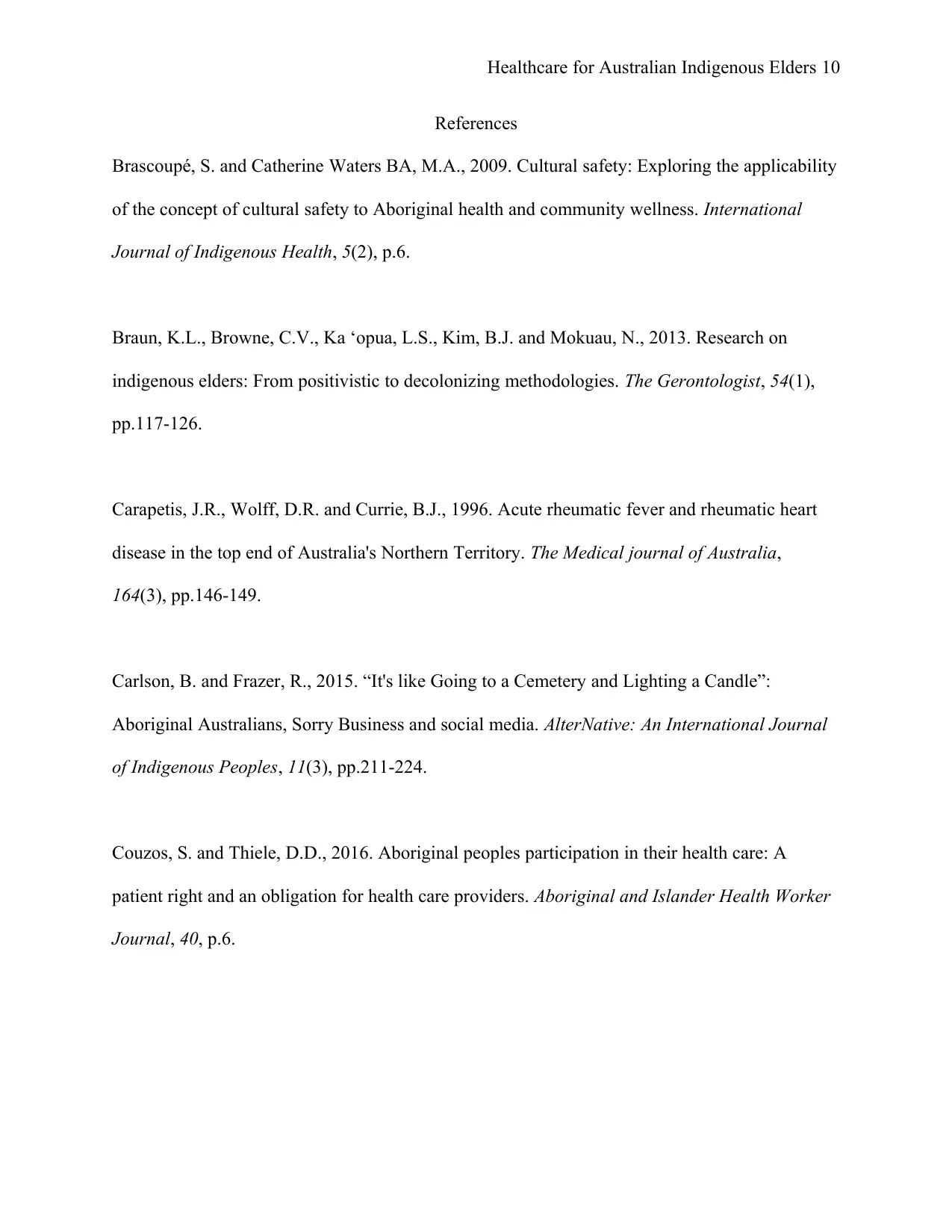
Healthcare for Australian Indigenous Elders 10
References
Brascoupé, S. and Catherine Waters BA, M.A., 2009. Cultural safety: Exploring the applicability
of the concept of cultural safety to Aboriginal health and community wellness. International
Journal of Indigenous Health, 5(2), p.6.
Braun, K.L., Browne, C.V., Ka ‘opua, L.S., Kim, B.J. and Mokuau, N., 2013. Research on
indigenous elders: From positivistic to decolonizing methodologies. The Gerontologist, 54(1),
pp.117-126.
Carapetis, J.R., Wolff, D.R. and Currie, B.J., 1996. Acute rheumatic fever and rheumatic heart
disease in the top end of Australia's Northern Territory. The Medical journal of Australia,
164(3), pp.146-149.
Carlson, B. and Frazer, R., 2015. “It's like Going to a Cemetery and Lighting a Candle”:
Aboriginal Australians, Sorry Business and social media. AlterNative: An International Journal
of Indigenous Peoples, 11(3), pp.211-224.
Couzos, S. and Thiele, D.D., 2016. Aboriginal peoples participation in their health care: A
patient right and an obligation for health care providers. Aboriginal and Islander Health Worker
Journal, 40, p.6.
References
Brascoupé, S. and Catherine Waters BA, M.A., 2009. Cultural safety: Exploring the applicability
of the concept of cultural safety to Aboriginal health and community wellness. International
Journal of Indigenous Health, 5(2), p.6.
Braun, K.L., Browne, C.V., Ka ‘opua, L.S., Kim, B.J. and Mokuau, N., 2013. Research on
indigenous elders: From positivistic to decolonizing methodologies. The Gerontologist, 54(1),
pp.117-126.
Carapetis, J.R., Wolff, D.R. and Currie, B.J., 1996. Acute rheumatic fever and rheumatic heart
disease in the top end of Australia's Northern Territory. The Medical journal of Australia,
164(3), pp.146-149.
Carlson, B. and Frazer, R., 2015. “It's like Going to a Cemetery and Lighting a Candle”:
Aboriginal Australians, Sorry Business and social media. AlterNative: An International Journal
of Indigenous Peoples, 11(3), pp.211-224.
Couzos, S. and Thiele, D.D., 2016. Aboriginal peoples participation in their health care: A
patient right and an obligation for health care providers. Aboriginal and Islander Health Worker
Journal, 40, p.6.
Paraphrase This Document
Need a fresh take? Get an instant paraphrase of this document with our AI Paraphraser

Healthcare for Australian Indigenous Elders 11
Couzos, S., Lea, T., Murray, R. and Culbong, M., 2005. ‘We are not just participants—we are in
charge’: the NACCHO ear trial and the process for Aboriginal community-controlled health
research. Ethnicity & Health, 10(2), pp.91-111.
Findandconnect.gov.au. (1961). Assimilation Policy - Summary | Find & Connect. [online]
Available at: https://www.findandconnect.gov.au/guide/sa/SE00796 [Accessed 27 Sep. 2018].
Hoy, W.E., Mathews, J.D., McCredie, D.A., Pugsley, D.J., Hayhurst, B.G., Rees, M., Kile, E.,
Walker, K.A. and Wang, Z., 1998. The multidimensional nature of renal disease: rates and
associations of albuminuria in an Australian Aboriginal community. Kidney international, 54(4),
pp.1296-1304.
Marrone, S., 2007. Understanding barriers to health care: a review of disparities in health care
services among indigenous populations. International Journal of Circumpolar Health, 66(3),
pp.188-198.
Mbuzi, V., Fulbrook, P. and Jessup, M., 2017. Indigenous peoples' experiences and perceptions
of hospitalization for acute care: A meta-synthesis of qualitative studies. International journal of
nursing studies, 71, pp.39-49.
Musharbash, Y., 2017. ‘Sorry Business is Yapa Way’: Warlpiri Mortuary Rituals as Embodied
Practice. In Mortality, mourning and mortuary practices in Indigenous Australia (pp. 43-58).
Routledge.
Couzos, S., Lea, T., Murray, R. and Culbong, M., 2005. ‘We are not just participants—we are in
charge’: the NACCHO ear trial and the process for Aboriginal community-controlled health
research. Ethnicity & Health, 10(2), pp.91-111.
Findandconnect.gov.au. (1961). Assimilation Policy - Summary | Find & Connect. [online]
Available at: https://www.findandconnect.gov.au/guide/sa/SE00796 [Accessed 27 Sep. 2018].
Hoy, W.E., Mathews, J.D., McCredie, D.A., Pugsley, D.J., Hayhurst, B.G., Rees, M., Kile, E.,
Walker, K.A. and Wang, Z., 1998. The multidimensional nature of renal disease: rates and
associations of albuminuria in an Australian Aboriginal community. Kidney international, 54(4),
pp.1296-1304.
Marrone, S., 2007. Understanding barriers to health care: a review of disparities in health care
services among indigenous populations. International Journal of Circumpolar Health, 66(3),
pp.188-198.
Mbuzi, V., Fulbrook, P. and Jessup, M., 2017. Indigenous peoples' experiences and perceptions
of hospitalization for acute care: A meta-synthesis of qualitative studies. International journal of
nursing studies, 71, pp.39-49.
Musharbash, Y., 2017. ‘Sorry Business is Yapa Way’: Warlpiri Mortuary Rituals as Embodied
Practice. In Mortality, mourning and mortuary practices in Indigenous Australia (pp. 43-58).
Routledge.
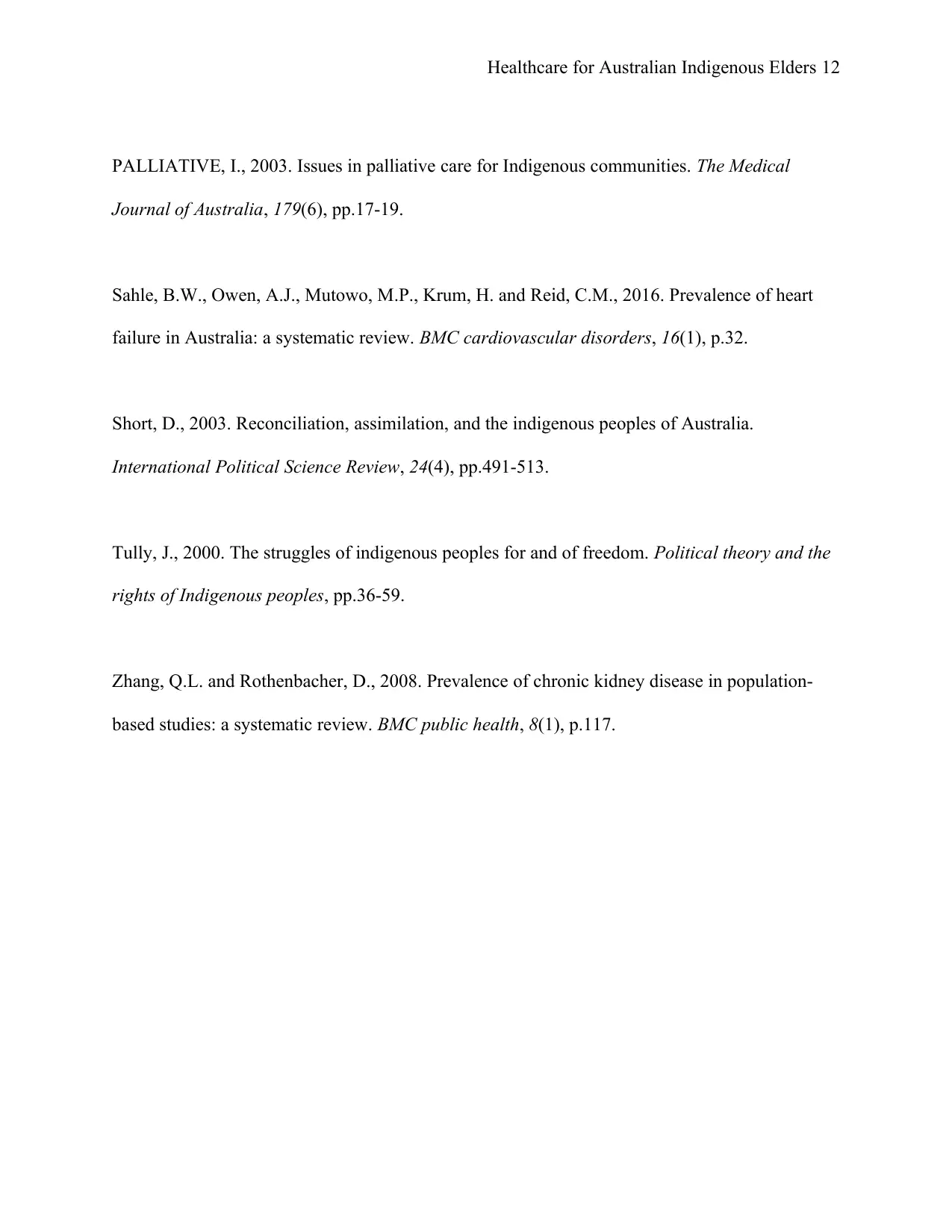
Healthcare for Australian Indigenous Elders 12
PALLIATIVE, I., 2003. Issues in palliative care for Indigenous communities. The Medical
Journal of Australia, 179(6), pp.17-19.
Sahle, B.W., Owen, A.J., Mutowo, M.P., Krum, H. and Reid, C.M., 2016. Prevalence of heart
failure in Australia: a systematic review. BMC cardiovascular disorders, 16(1), p.32.
Short, D., 2003. Reconciliation, assimilation, and the indigenous peoples of Australia.
International Political Science Review, 24(4), pp.491-513.
Tully, J., 2000. The struggles of indigenous peoples for and of freedom. Political theory and the
rights of Indigenous peoples, pp.36-59.
Zhang, Q.L. and Rothenbacher, D., 2008. Prevalence of chronic kidney disease in population-
based studies: a systematic review. BMC public health, 8(1), p.117.
PALLIATIVE, I., 2003. Issues in palliative care for Indigenous communities. The Medical
Journal of Australia, 179(6), pp.17-19.
Sahle, B.W., Owen, A.J., Mutowo, M.P., Krum, H. and Reid, C.M., 2016. Prevalence of heart
failure in Australia: a systematic review. BMC cardiovascular disorders, 16(1), p.32.
Short, D., 2003. Reconciliation, assimilation, and the indigenous peoples of Australia.
International Political Science Review, 24(4), pp.491-513.
Tully, J., 2000. The struggles of indigenous peoples for and of freedom. Political theory and the
rights of Indigenous peoples, pp.36-59.
Zhang, Q.L. and Rothenbacher, D., 2008. Prevalence of chronic kidney disease in population-
based studies: a systematic review. BMC public health, 8(1), p.117.
⊘ This is a preview!⊘
Do you want full access?
Subscribe today to unlock all pages.

Trusted by 1+ million students worldwide
1 out of 12
Related Documents
Your All-in-One AI-Powered Toolkit for Academic Success.
+13062052269
info@desklib.com
Available 24*7 on WhatsApp / Email
![[object Object]](/_next/static/media/star-bottom.7253800d.svg)
Unlock your academic potential
Copyright © 2020–2025 A2Z Services. All Rights Reserved. Developed and managed by ZUCOL.





